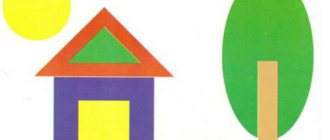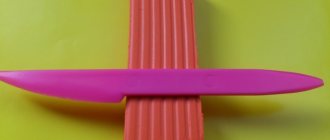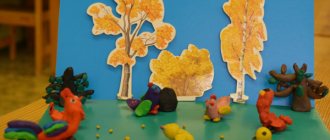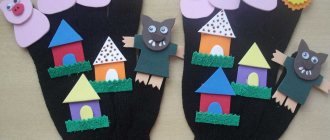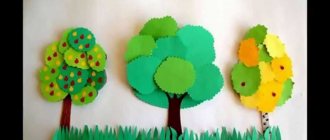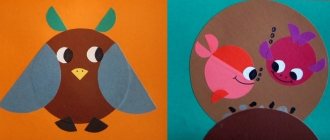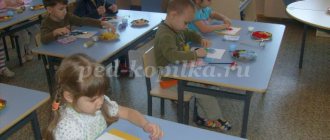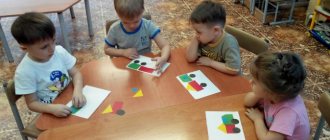Modeling a duck outline of a lesson on applique, modeling (middle group) on the topic
Summary of GCD for modeling in the middle group
Duck theme
1. Goal: to teach children to sculpt an object consisting of several parts, showing some characteristic features (an elongated beak, a tail).
Tasks: - Reinforce modeling techniques: rolling the dough between the palms; - Practice using pinching and pulling techniques; - Strengthen the ability to connect parts, pressing them tightly against each other, and smoothing the seams; — Cause a positive emotional response to the overall result.
Vocabulary work: beak, tail.
2. Methodological techniques: verbal (guessing riddles about a duck), visual (examining a toy duck with children), explanation (what is the shape of the body, what is the head, beak, tail).
3. Materials and equipment: salted colored dough; boards; napkins; for each child there are toys - a diagram for sculpting a duck); toys – pet birds; musical accompaniment (dance of little ducklings).
4. Organize children in classes into subgroups.
5. Preliminary work. Conversation with children about poultry (geese, ducks, chickens); looking at illustrations of ducklings, chickens, geese, goslings; game “How are they similar? What is the difference?" (comparison of chicks and ducklings); guessing riddles about birds.
Progress of the lesson.
(Getting a riddle) She walks in the rain, loves to cut grass! "Quack!" shouts, This is all a joke, Well, of course, it’s... (Duck!) - Well done, guys, but here’s another riddle. Amazing child! Just came out of diapers Can swim and dive, Like his own mother (Duckling!)
- Well done! So you guessed it. This is a duck and ducklings.
- Guys, the ducklings were playing, swimming and lost their mother, and they began to call their mother “Quack-quack-quack!”, but mother did not respond. The ducklings ask you to help find their mother duck. Let's help them! How can we help them, guys? (answer options): ... you can blind...
- Of course, you can make a duck! But first, let's play with you a little. The ducks came out into the meadow, (we walk like ducklings) - Quack-Quack-Quack! A cheerful beetle flew by - Zhzhzhzhzh! (we wave our arms - wings). Geese arch their necks - Ga-Ga-Ga (circular rotation of the neck). The feathers are straightened with the beak (the body turns left and right). The wind swayed the branches (we swing our arms up), Sharik also growled - Rrrrr... (hands on the belt, bending forward, looking in front of us). The reeds whispered in the water - Shhhhhhhh... (raise your arms up and stretch), And again there was silence - Shhhhhhh... (crouched down). - Well done! Now sit down at the tables, we must help the ducklings. Look, guys, what wonderful colored dough is on our plates. Touch it, what is it like?.. (Soft, yellow...). - Look, children, what parts does a duck consist of? (Head, torso. Head is smaller, torso is larger). -What do you think this is? (Beak, tail).
- Well done! First you need to divide the dough into two parts. One piece of dough, which is larger, will be the body; a smaller piece is the head. To sculpt the body of a duck, we need to take a larger piece of dough and roll it into an oval with our palms. Then we also sculpt the head, only with a ball. Next, we connect these two parts, pressing them tightly against each other. But be very careful so that the shape does not break. Then we guys, by pinching, make a beak on the duck’s head and pull it back a little, and on the body, where the tail should be, we pull it out. Look how I do it. Our mother duck is almost ready. Is she missing some eyes or something else? (Wings!) - Look, you have buckwheat cereal on your plate, make eyes out of it for the duck. Carefully! Where the eyes should be, press the grain. If everything is clear, get to work. (Music sounds, children get to work). - Our ducklings in the pond are really waiting for their mothers - ducks! (The children finished their work).
Educator: Now, guys, let’s go and put all the mother ducks on the lake. There is a fish in the pond, and ducklings love to eat this fish in the mornings, in the mornings and evenings. And of course at lunch too! The fish will help them grow!
How many ducks! Let's count them guys! Well done, you did a great job today! Look how happy the ducklings are! And the duck is happy too! Everyone has fun, and so do we! After all, we did a good deed. Is it true? (Yes)
- Guys, let's dance the “little ducklings” dance. Please everyone stand in a circle. Now listen to the music and repeat all the movements after me.
(Music sounds. Children dance the dance of little ducklings). - What great fellows you are! I and the ducklings thank you for the wonderful dance.
Summary of a modeling lesson in the middle group on the topic Duck
Open lesson Theme “Duck” (Modeling middle group)
Author: Elena Ivanovna Vagner Educator, Municipal Preschool Educational Institution “Poltava Kindergarten “Rodnichok””
1. Purpose: to teach children
sculpt an object consisting of several parts, showing some characteristic features (elongated beak, tail).
Tasks: - Reinforce modeling techniques: rolling the dough between the palms; - Practice using pinching and pulling techniques; - Strengthen the ability to connect parts, pressing them tightly against each other, and smoothing the seams; — Cause a positive emotional response to the overall result.
Vocabulary work: beak, tail.
2. Methodological techniques: verbal (guessing riddles about a duck), visualization (looking at a toy duck with children), explanation (what shape is the body, what is the head, beak, tail), independence (children’s work), moment (providing individual assistance by the teacher), surprise (dance around the lake in hats and masks).
3. Materials and equipment: salted colored dough; boards; napkins; duck toys for each child); lake is a mirror; duck mask hats for each child; house layout; wattle fence; toys – pet birds; hostess costume for the teacher; musical accompaniment; a huge toy egg to encourage children and “Worms” marmalade.
4. Organize children in classes into subgroups.
5. Preliminary work. Conversation with children about poultry (geese, ducks, chickens); looking at illustrations of ducklings, chickens, geese, goslings; game “How are they similar? What is the difference?" (comparison of chicks and ducklings); guessing riddles about birds.
(Children enter the group and are greeted by a teacher in Russian folk costume). Educator: Hello, guys! Children: Hello! (Music sounds from the voices of poultry and animals). Educator: Oh, what guests I have! I'm so glad to see you! Come in, dear guests! And I was just about to feed my poultry. Now you can guess which birds. She walks in the rain and loves to cut grass! "Quack!" screams, This is all a joke, Well, of course it is... Children: Duck! Educator: Well done, guys, here's another riddle. Amazing child! Just out of diapers He can swim and dive, like his own mother. Children: Duckling!
Educator: Well done! So you guessed it. This is a duck and ducklings. They are not in the yard, they probably went to the lake. Let's go look for them. (Children pass a strip with physical education equipment: a bridge; hummocks. The teacher and the children approach the table on which the lake is decorated. They surround it on all sides. One duck swims on the lake). Educator: Look, guys, the duck is swimming alone, you can see the kids are hiding in the grass. The mother duck felt lonely and began to call them. “Quack-quack-quack!”, but the ducklings don’t respond. Mother duck asks you to help find her ducklings. Let's help her! How can we help her, guys? Children (answer options): ... you can blind...
Educator: of course, you can make ducklings! But first, let's play with you a little. The ducks came out into the meadow, (we walk like ducklings) - Quack-Quack-Quack! A cheerful beetle flew by - Zhzhzhzhzh! (we wave our arms - wings). Geese arch their necks - Ga-Ga-Ga (circular rotation of the neck). The feathers are straightened with the beak (the body turns left and right). The wind swayed the branches (we swing our arms raised up), Sharik also growled - Rrrrr... (hands on the belt, bending forward, looking in front of us
). The reeds whispered in the water - Shhhhhhhh... (raise your arms up and stretch), And again there was silence - Shhhhhhh... (crouched down). Educator: Well done! Now sit down at the tables, we must help the mother duck. Look, guys, what wonderful colored dough is on our plates. Touch it, what is it like?.. Children: Soft, yellow... Educator: Look, children, what parts does a duck consist of? Children: Head, torso. The head is smaller, the body is larger. Educator: What do you think, what is this? Children: Beak, tail.
Educator: Well done! First you need to divide the dough into two parts. One piece of dough, which is larger, will be the body; a smaller piece is the head. To sculpt the body of a duck, we need to take a larger piece of dough and roll it into an oval with our palms. Then we also sculpt the head, only with a ball. Next, we connect these two parts, pressing them tightly against each other. But be very careful so that the shape does not break. Then we guys pinched the beak on the duckling’s head and pulled it back a little, and on the body, where the tail should be, we pulled it out. Look how I do it. Our duckling is almost ready. Is he missing some eyes or something else? Children: Wings!.. Teacher: Look, you have cereal in your plate - buckwheat, make eyes out of it for the duckling. Carefully! Where the eyes should be, press the grain. If everything is clear, start the lesson. (Music sounds, children start the lesson). Educator: Our duck in the pond is really looking forward to her ducklings! (The children finished their work).
Educator: Now, guys, let’s go and put all the ducklings on the lake. There is a fish in the pond, and ducklings love to eat this fish in the mornings, in the mornings and evenings. And of course at lunch too! The fish will help them grow!
Our duck is one, but there are many ducklings! Let's count them guys! Well done, you did a great job today! Look how happy the mother duck is! And the ducklings are happy too, they have returned to their mother! Everyone has fun, and so do we! After all, we did a good deed. Is it true? Children: Yes!!
Educator: So that our guests also have a good mood, let's dance for them together with our duck and ducklings. Please, everyone stand in a circle around the lake, and I will put on duckling hats and masks for you. Now listen to the music and repeat all the movements after me.
(Music sounds. Children dance the dance of little ducklings). Educator: What great fellows you are! Me and the duck thank you for the wonderful dance. And the duck also wants to thank you for returning the babies to her! She passed on treats. Now let’s not bother our duck and ducklings, let’s go to our group. (Children leave).
Summary of GCD for modeling "Duck" in the middle group
Municipal budgetary educational institution
kindergarten No. 21
Summary of GCD for modeling in the middle group
Duck theme
Author: Kalinina Evgeniya Viktorovna
1. Target:
teach children to sculpt an object consisting of several parts, showing some characteristic features (elongated beak, tail).
Tasks:
— Reinforce modeling techniques: rolling the dough between your palms; - Practice using pinching and pulling techniques; - Strengthen the ability to connect parts, pressing them tightly against each other, and smoothing the seams; — Cause a positive emotional response to the overall result.
Vocabulary work:
beak, tail.
2. Methodical techniques:
verbal (guessing riddles about a duck), visual (looking at a toy duck with children), explanation (what shape is the body, what is the head, beak, tail).
3. Materials and equipment:
salted colored dough; boards; napkins; for each child there are toys - a diagram for sculpting a duck); toys – pet birds; musical accompaniment (dance of little ducklings).
4. Organization of children
during the lesson in subgroups.
5. Preliminary work.
Conversation with children about poultry (geese, ducks, chickens); looking at illustrations of ducklings, chickens, geese, goslings; game “How are they similar? What is the difference?" (comparison of chicks and ducklings); guessing riddles about birds.
Progress of the lesson.
(Puzzling a riddle)
Spout with a spatula,
Red paws.
Swims, dives.
Loves to quack! (Duck.) - Well done, guys, but here’s another riddle. Amazing child! Just came out of diapers Can swim and dive, Like his own mother (Duckling!)
- Well done! So you guessed it. This is a duck and ducklings.
- Guys, the ducklings were playing, swimming and lost their mother, and they began to call their mother “Quack-quack-quack!”, but mother did not respond. The ducklings ask you to help them find their mother duck. Let's help them! How can we help them, guys? (answer options): ... you can blind...
- Of course, you can make a duck! But first, let's play with you a little.
The ducks were flying, (Children are running, waving their hands)
They flapped their wings,
Bend over the water, (Bend over)
They shake their heads.
They know how to stand straight and proud,
They land on the water very silently. (Squat)
- Well done! Now sit down at the tables, we must help the ducklings. Look, guys, what wonderful colored dough is on our plates. Touch it, what is it like?.. (Soft, yellow...). - Look, children, what parts does a duck consist of? (Head, torso. Head is smaller, torso is larger). -What do you think this is? (Beak, tail).
- Well done! First you need to divide the dough into two parts. One piece of dough, which is larger, will be the body; a smaller piece is the head. To sculpt the body of a duck, we need to take a larger piece of dough and roll it into an oval with our palms. Then we also sculpt the head, only with a ball. Next, we connect these two parts, pressing them tightly against each other. But be very careful so that the shape does not break. Then we guys, by pinching, make a beak on the duck’s head and pull it back a little, and on the body, where the tail should be, we pull it out. Look how I do it. Our mother duck is almost ready. Is she missing some eyes or something else? (Wings!) - Look, you have buckwheat cereal on your plate, make eyes out of it for the duck. Carefully! Where the eyes should be, press the grain. If everything is clear, get to work. (Music sounds, children get to work). - Our ducklings in the pond are really waiting for their mothers - ducks! (The children finished their work).
Educator: Now, guys, let’s go and put all the mother ducks on the lake. How many ducks! Let's count them guys! Well done, you did a great job today! Look how happy the ducklings are! And the duck is happy too! Everyone has fun, and so do we! After all, we did a good deed. Is it true? (Yes)
- Guys, let's dance the “little ducklings” dance. Please everyone stand in a circle. Now listen to the music and repeat all the movements after me.
(Music sounds. Children dance the dance of little ducklings). - What great fellows you are! I and the ducklings thank you for the wonderful dance.
